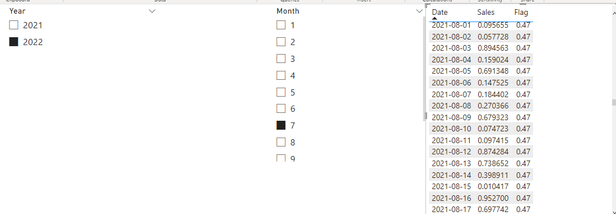- Power BI forums
- Updates
- News & Announcements
- Get Help with Power BI
- Desktop
- Service
- Report Server
- Power Query
- Mobile Apps
- Developer
- DAX Commands and Tips
- Custom Visuals Development Discussion
- Health and Life Sciences
- Power BI Spanish forums
- Translated Spanish Desktop
- Power Platform Integration - Better Together!
- Power Platform Integrations (Read-only)
- Power Platform and Dynamics 365 Integrations (Read-only)
- Training and Consulting
- Instructor Led Training
- Dashboard in a Day for Women, by Women
- Galleries
- Community Connections & How-To Videos
- COVID-19 Data Stories Gallery
- Themes Gallery
- Data Stories Gallery
- R Script Showcase
- Webinars and Video Gallery
- Quick Measures Gallery
- 2021 MSBizAppsSummit Gallery
- 2020 MSBizAppsSummit Gallery
- 2019 MSBizAppsSummit Gallery
- Events
- Ideas
- Custom Visuals Ideas
- Issues
- Issues
- Events
- Upcoming Events
- Community Blog
- Power BI Community Blog
- Custom Visuals Community Blog
- Community Support
- Community Accounts & Registration
- Using the Community
- Community Feedback
Register now to learn Fabric in free live sessions led by the best Microsoft experts. From Apr 16 to May 9, in English and Spanish.
- Power BI forums
- Forums
- Get Help with Power BI
- Desktop
- %Turnover over a Range of Months
- Subscribe to RSS Feed
- Mark Topic as New
- Mark Topic as Read
- Float this Topic for Current User
- Bookmark
- Subscribe
- Printer Friendly Page
- Mark as New
- Bookmark
- Subscribe
- Mute
- Subscribe to RSS Feed
- Permalink
- Report Inappropriate Content
%Turnover over a Range of Months
Hi,
I currently have the following DAX Calulcations Termination and Headcount to work out the % Turnover
Terminations =
CALCULATE(
COUNT('Fact'[Emp Id]),
USERELATIONSHIP('Fact'[Employment End Date],Dates[Date]),
NOT(ISBLANK('Fact'[Employment End Date])),
'Fact'[Employment End Date] <= TODAY()
)+0
Headcount =
CALCULATE(
COUNTX(
FILTER('Fact','Fact'[Employment Start Date]<=MAX('Dates'[Date])
&&
(ISBLANK('Fact'[Employment End Date])
|| 'Fact'[Employment End Date]>MAX(Dates[Date]))),
'Fact'[Personnel Number]),ALL('Termination Category'[Termination Category])
) + 0
% Turnover =
VAR _Headcount =
CALCULATE(
COUNTX(
FILTER('Fact','Fact'[Employment Start Date]<=MAX('Dates'[Date])
&&
(ISBLANK('Fact'[Employment End Date])
|| 'Fact'[Employment End Date]>MAX(Dates[Date]))),
'Fact'[Personnel Number]),ALL('Termination Category'[Termination Category])
) + 0
VAR _AvgHeadcount =
AVERAGEX(
VALUES(Dates[Date]),
[Headcount]
) + 0
VAR _Turnover =
DIVIDE('Calculations'[Terminations],_AvgHeadcount,BLANK())
RETURN
_Turnover
But if the end user selects the Year = 2022 and Month = July I want to see the % Turnover on average over the previous 12 months i.e 01/08/2022 to 31/07/2022
other examples of date range to return if they select the highlighted Month Year dates
June 2022 (should display turnover from 01/07/2021 to 30/06/2022)
May 2022 (should display turnover from 01/06/2021 to 31/05/2022)
April 2022 (should display turnover from 01/05/2021 to 30/04/2022)
Thanks
- Mark as New
- Bookmark
- Subscribe
- Mute
- Subscribe to RSS Feed
- Permalink
- Report Inappropriate Content
Hi @v-yangliu-msft Thanks for your reply, just look at your example and not sure if it is working because when selecting the different Month or Years the adjacent table would not show the dates within that date range, all dates are showing
- Mark as New
- Bookmark
- Subscribe
- Mute
- Subscribe to RSS Feed
- Permalink
- Report Inappropriate Content
Hi @PowerAuto82 ,
I created some data:
Here are the steps you can follow:
1. Create calculated table.
Date =
DISTINCT('Table1'[Date])Create caluculated column.
Year = YEAR('Date'[Date])Month = MONTH('Date'[Date])2. Create measure.
Flag =
var _year=SELECTEDVALUE('Date'[Year])
var _month=SELECTEDVALUE('Date'[Month])
var _start=
DATE(
_year,_month-11,1)
var _end=
EOMONTH(
DATE(
_year,_month,1),0)
return
AVERAGEX(FILTER(ALL(Table1),
'Table1'[Date]>=_start&&'Table1'[Date]<=_end),[Sales])3. Result:
If you need pbix, please click here.
%Turnover over a Range of Months.pbix
If this method can't meet your requirement, can you share sample data and sample output in table format? Or a sample pbix after removing sensitive data. We can better understand the problem and help you
Best Regards,
Liu Yang
If this post helps, then please consider Accept it as the solution to help the other members find it more quickly
Helpful resources

Microsoft Fabric Learn Together
Covering the world! 9:00-10:30 AM Sydney, 4:00-5:30 PM CET (Paris/Berlin), 7:00-8:30 PM Mexico City

Power BI Monthly Update - April 2024
Check out the April 2024 Power BI update to learn about new features.

| User | Count |
|---|---|
| 113 | |
| 100 | |
| 78 | |
| 76 | |
| 52 |
| User | Count |
|---|---|
| 146 | |
| 109 | |
| 106 | |
| 88 | |
| 61 |




